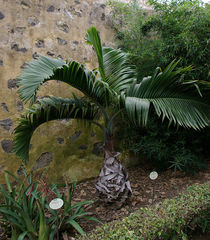

Permission: Some rights reserved
Bottle palm
Bottle Palm has a large swollen trunk. It is a myth that the trunk is a means by which the palm stores water. Bottle Palm has only four to six leaves open at any time. The flowers of the palm arise from under the crownshaft.The Bottle Palm (Hyophorbe lagenicaulis) is a species of plant of the family Arecaceae. The Bottle Palm gets its name from its trunk, which has a swollen appearance, although whether the “bottle” refers to the shape of the trunk or to the myth that the plant stores water in the trunk is unclear. The leaves of the Bottle Palm are long and feathered, with only four to six leaves open at any one time. Bottle Palms can grow to a height of 3 to 3.5 meters.
Bottle Palms are native to the Republic of Mauritius, an island nation off the southeast coast of Africa, about 900 kilometers east of Madagascar. The Bottle Palm is extremely sensitive to cold and rarely survives temperatures lower than zero degrees Celsius. Bottle Palms have been successfully cultivated in California, Texas and Florida in the United States, but can be grown as a container plant in other areas if sheltered and not over-watered.
Bottle Palms are restricted to Round Island, Mauritius. Classified as a Nature Reserve in 1957, Round Island is now protected by both the Mauritian Wildlife Foundation and by Mauritius’ National Parks and Conservation Service. For the Bottle Palm, protection came in the nick of time, as the population on Mauritius proper was as low as eight individual plants at one point.
Illustrated records, historical maps and photographs from the 1920s indicate that at one time, Bottle Palms were abundantly present on mainland Mauritius and on surrounding islets, including Isle aux Aigrette. Goats and rabbits introduced to the ecosystem are blamed for the dramatic decline in the population of the Bottle Palm.
Today, Bottle Palms from Round Island are being extensively cultivated on Mauritius, while efforts are also being made to utilise the older palms on Mauritius to preserve genetic diversity. The Global Environment Facility (GEF), an independent financial organisation that provides grants to developing countries to improve the global environment, has established a new population of Bottle Palms on Isle aux Aigrette as part of the effort to conserve and protect the plant.
The Mauritian Wildlife Foundation maintains permanent wardens on Round Island to protect the habitat of the Bottle Palm. The foundation works hard to ensure that the mammals that so devasted the palm population of Mauritius do not reach Round Island.
